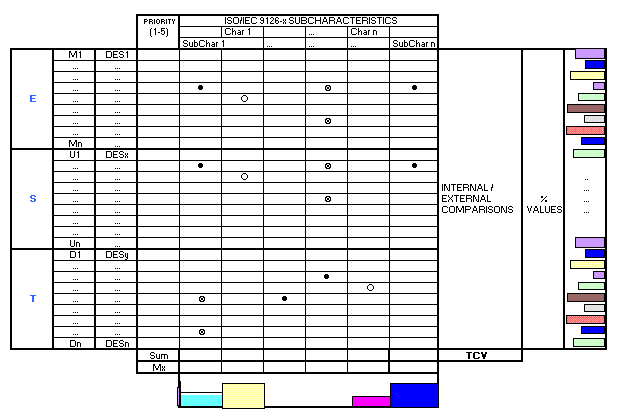 QF2D
QF2D Publications / Related Publications
Publications / Related Publications
 QF2D
QF2D Publications / Related Publications
Publications / Related Publications -
-


After trialling the Quality Factor (QF) technique, a list of improvement points has been identified, such as:
QFD is a method originated in the late ‘60s in Japan as a means of translating customer requirements (the so-called “Voice of the Customer”) into appropriate technical requirements throughout the development and production of a product. In the ‘80s this method was introduced in North America and since then it has received a widespread diffusion and adoption all over the world, expanding his initial focus on the product to the whole production chain (the “4 phases of QFD”: HoQ (or Design), Parts (or Details), Process, Production).
QFD includes a series of matrixes, which are the tools used to represent
data but the most commonly used matrix is the “House of Quality” (HoQ).
This matrix approach represents a good communication tool, offering to
express a balanced consideration of requirements and providing a mechanism
to communicate hidden knowledge through the organisation, but is the means
and not the end. The real value is represented by the sharing of communication
and decision-making among people of the different functional departments
involved in the product development, from Marketing to Product Support.
QFD helps development personnel in maintaining the correct focus on most
relevant requirements, minimising the misunderstanding of the customer
needs. For these reasons, QFD represents an effective communication and
quality-planning tool. QFD has traditionally been used in the manufacturing
industry with great achievements, leading to remarkable reductions in overall
project costs (e.g. 50%), project cycle time (e.g. 33%) and major increases
in productivity (e.g. 200%). Main reference for QFD is the QFD Institute. A paper about the selection of proper QFD tool can be downloaded clicking here. A free tool is Easy-QFD by Prof. Dr. Georg Herzwurm.
Some templates and tools MS-Excel based, also for QFD, are available at MathTools.net.
Maintaining the QF basic points, QF2D presents these main improvements:

Note that those matrices were previously named as D/M (Development/Mainteinance) and A (Assessment) ones.
Through a 6-steps procedure, as in QF, it is possible to calculate the final product quality value. Figure 2 shows the QF2D matrix:

Figure 2 - A sample D Matrix
Click here to download an Excel template for
calculating QF2D (87 Kb) and a Word document (here) containing the questionnaire and the ISO/IEC 9126:2000 definitions.
Note that you have to tailor the template
according to the number of desiderata (in the D matrix) or products features
(in the I matrix) chosen and use the ISO/IEC 14598-1 ratings in place of
QF2D symbols. For all details, you can refer to the below cited publications
describing the technique.
Publications 
 L.Buglione & A.Abran, QF2D: a different way to measure Software Quality, IWSM2000 (10th International Workshop on Software Measurement), Berlin, Germany, October 4-6, 2000
L.Buglione & A.Abran, QF2D: a different way to measure Software Quality, IWSM2000 (10th International Workshop on Software Measurement), Berlin, Germany, October 4-6, 2000
![]()
![]()
 L.Buglione & A.Abran, QF2D: a different way to measure Software Quality, included in: New Approaches in Software Measurement, 10th International Workshop on Software Measurement, IWSM 2000, Berlin, Germany, October 4-6, 2000. Proceedings, Dumke R. & Abran A. (Eds.), February 2001, ISBN 3-540-41727-3 (referred in ACM Portal)
L.Buglione & A.Abran, QF2D: a different way to measure Software Quality, included in: New Approaches in Software Measurement, 10th International Workshop on Software Measurement, IWSM 2000, Berlin, Germany, October 4-6, 2000. Proceedings, Dumke R. & Abran A. (Eds.), February 2001, ISBN 3-540-41727-3 (referred in ACM Portal)
![]()
 L.Buglione & A.Abran, QF2D: Quality Factor through QFD application, Qualita2001 (4th International Congress on Quality and Reliability), Annecy, France, March 22-23, 2001, ISBN 2-9516453-0-0, pp. 34-39
L.Buglione & A.Abran, QF2D: Quality Factor through QFD application, Qualita2001 (4th International Congress on Quality and Reliability), Annecy, France, March 22-23, 2001, ISBN 2-9516453-0-0, pp. 34-39
![]()
![]()
 L.Buglione, N.Kececi & A.Abran, An Integrated Graphical assessment for managing Software Product Quality, Proceedings of the 12 ICSQ (12th International Software Quality Conference: Managing for Software Quality and Service Quality), Ottawa (Canada), October 28-30, 2002
L.Buglione, N.Kececi & A.Abran, An Integrated Graphical assessment for managing Software Product Quality, Proceedings of the 12 ICSQ (12th International Software Quality Conference: Managing for Software Quality and Service Quality), Ottawa (Canada), October 28-30, 2002
![]()
![]()
External References
 Prasad V.C.S,
An Approach to Quality Management at the Early Stages of New Product Development Using Technology Adoption Life-Cycle Concepts, ASQ Software Quality Professional, Vol.7, No.4, pp.27-33
Prasad V.C.S,
An Approach to Quality Management at the Early Stages of New Product Development Using Technology Adoption Life-Cycle Concepts, ASQ Software Quality Professional, Vol.7, No.4, pp.27-33
 Suryn W., Stambollian A., Dormeux J.C., Luc Bégnoche L., Software Quality Engineering – where to find it in Software Engineering Body of Knowledge (SWEBOK), Proceedings of 14th International Software Quality Management & INSPIRE Conference 2006, Southampton, Hampshire, UK 10-12 April 2006
Suryn W., Stambollian A., Dormeux J.C., Luc Bégnoche L., Software Quality Engineering – where to find it in Software Engineering Body of Knowledge (SWEBOK), Proceedings of 14th International Software Quality Management & INSPIRE Conference 2006, Southampton, Hampshire, UK 10-12 April 2006
 Alvarez J.C., Panorámica del estado actual del modelo EFQM para la evaluación de la calidad del software, I° Simposio sobre avances en gestión de proyectos y calidad del software (AGPCSW04), Universidad de Salamanca, pp. 156-165, Salamanca (Spain), October 21-23 2004
Alvarez J.C., Panorámica del estado actual del modelo EFQM para la evaluación de la calidad del software, I° Simposio sobre avances en gestión de proyectos y calidad del software (AGPCSW04), Universidad de Salamanca, pp. 156-165, Salamanca (Spain), October 21-23 2004